
National coordinator (during Phase VI)
Maurizio Sabatti

The European Information System on Forest Genetic Resources (EUFGIS) provides geo-referenced and harmonized data on genetic conservation units of forest trees in Europe.
Mediterranean-type environments rival tropical regions for their biological richness, particularly in terms of plant and forest tree species. In contrast to other parts of the world, however, the Mediterranean basin has a long history of human disturbance that has affected the structure and function of most of the forests and, in general, plant communities in the region. Diversity of plant species has even increased in certain ecosystems as a result of “human-driven relatively rapid evolution under stress by drought, fire, grazing and cutting”.
Forest trees represent an important component of the Mediterranean flora, where the number of tree species is larger (100) than trees present in Central Europe (30), with the genus Quercus alone presenting more than 20 species in the Mediterranean region. Many of the Holarctic and Eurasian tree species survived during the glacial ages in Mediterranean refugia, including in the Italian peninsula, from where they re-colonized the continent when temperatures rose again at the end of glaciations, about 15 000 to 10 000 years ago. The Mediterranean region also harbours many endemic species such as Pinus leucodermis and Abies nebrodensis (Sicily). Many other tree species, such as beech and silver fir, also have more diverse gene pools in southern Europe, highlighting the need for a more detailed knowledge of the genetic variation of Mediterranean forest trees.
In 2001, Italy approved a National Strategy for the conservation and sustainable use of forest genetic resources. Guidelines for forest management were also established and a list of measures for the protection, preservation, amelioration and development of the forestry sector were clearly defined. In 2006, a framework programme for the forestry sector (PQSF) was issued, providing support to the individual Italian regions in planning and approving measures in favour of sustainable forest management. The PQSF identifies four priorities for a ten-year period (2009-2019):
Several of the EUFORGEN Technical Guidelines have been translated into Spanish, published by Regione Lazio, Direzione Regionale Ambiente e Cooperazione tra i Popoli, Centro Regionale di Educazione e Informazione Ambientale (CREIA).
You can download them below.
Abies alba (1.83 MB)
Acer campestre (2.05 MB)
Acer pseudoplatanus (2.37 MB)
Alnus glutinosa (1.39 MB)
Castanea sativa (2.03 MB)
Fraxinus excelsior (1.50 MB)
Malus sylvestris (2.15 MB)
Picea abies (3.33 MB)
Pinus halepensis (2.81 MB)
Pinus nigra (3.83 MB)
Pinus pinaster (2.86)
Pinus pinea (3.43 MB)
Populus nigra (1.85 MB)
Prunus avium (1.91 MB)
Quercus robur / petraea (1.85 MB)
Sorbus domestica (2.16 MB)
Sorbus torminalis (1.85 MB)
Tilia spp. (1.83 MB)
Genetic conservation and management of Quercus suber

Populus nigra Network: Report of the first meeting

Quercus suber Network: Report of the third and fourth meetings

Populus nigra Network: Report of the fifth meeting

Populus nigra Network: Report of the fourth meeting

Picea abies Network: Report of the second meeting

Populus nigra Network: Report of the seventh and eighth meeting

Conifers Network: Report of the first meeting